History > AS Mark Scheme > GCE History A Y216/01: The USA in the 19th century: Westward expansion and Civil War 1803-c.1890 Adv (All)
GCE History A Y216/01: The USA in the 19th century: Westward expansion and Civil War 1803-c.1890 Advanced GCE Mark Scheme for November 2020
Document Content and Description Below
Oxford Cambridge and RSA Examinations GCE History A Y216/01: The USA in the 19th century: Westward expansion and Civil War 1803-c.1890 Advanced GCE Mark Scheme for November 2020Oxford Cambridge ... and RSA Examinations OCR (Oxford Cambridge and RSA) is a leading UK awarding body, providing a wide range of qualifications to meet the needs of candidates of all ages and abilities. OCR qualifications include AS/A Levels, Diplomas, GCSEs, Cambridge Nationals, Cambridge Technicals, Functional Skills, Key Skills, Entry Level qualifications, NVQs and vocational qualifications in areas such as IT, business, languages, teaching/training, administration and secretarial skills. It is also responsible for developing new specifications to meet national requirements and the needs of students and teachers. OCR is a not-for-profit organisation; any surplus made is invested back into the establishment to help towards the development of qualifications and support, which keep pace with the changing needs of today’s society. This mark scheme is published as an aid to teachers and students, to indicate the requirements of the examination. It shows the basis on which marks were awarded by examiners. It does not indicate the details of the discussions which took place at an examiners’ meeting before marking commenced. All examiners are instructed that alternative correct answers and unexpected approaches in candidates’ scripts must be given marks that fairly reflect the relevant knowledge and skills demonstrated. Mark schemes should be read in conjunction with the published question papers and the report on the examination. © OCR 2020Y216/01 Mark Scheme November 2020 2 Annotations Annotation Meaning of annotation Blank Page Highlight Off-page comment Assertion Analysis Evaluation Explanation Factor Illustrates/Describes Irrelevant, a significant amount of material that does not answer the question Judgement Knowledge and understanding Provenance Simple comment Unclear ViewY216/01 Mark Scheme November 2020 3 Subject Specific Marking Instructions Question Answer Mark Guidance 1 (a) Which of the following was a greater success for Native Americans? i. Tecumseh’s Confederacy ii. The ‘Indian Wars’ of the 1860s and 1870s Explain your answer with reference to both (i) and (ii). • In dealing with Tecumseh’s Confederacy answers might consider that it united different Native American tribes to a greater extent than any other form of resistance in the nineteenth century. • Answers might consider the successful leadership of Tecumseh, both in his relations with Whites and his leadership of Native Americans. • Answers might consider the significance of the war of 1812 and Tecumseh’s decision to ally with the British. • In dealing with the ‘Indian Wars’ answers might consider the impact of these conflicts on the settlement and economic exploitation of the ‘Great Plains’. • Answers might consider that these were a series of independent conflicts, rather than a united resistance movement. • Answers might consider specific military successes and failures such as ‘Custer’s Last Stand’ at Little Bighorn or the Sand Creek Massacre. 10 • No set answer is expected • Judgement must be supported by relevant and accurate material. • Only credit material relevant to Native American resistance against America and America settlers. • Answers may deal with each factor in turn, then compare them to reach a judgement, or make take a continually comparative approach. Either approach is acceptable. • Knowledge must not be credited in isolation, it should only be credited where it is used as the basis for analysis and evaluation, in line with descriptions in the levels marks scheme.Y216/01 Mark Scheme November 2020 4 1 (b)* ‘The actions of John Brown were the main reason for the breakdown of relations between the Northern and Southern states of the USA in the years from 1850 to 1861.’ How far do you agree? In arguing that the actions of John Brown were the main reason, answers might consider: • John Brown’s attempt to arm slaves by stealing weapons from Harpers Ferry in 1859 represented one of the greatest fears of the Southern states coming true. • Answers might consider that the reaction to John Brown’s raid and trial was polarising. • Answers may also consider John Brown’s violent actions in Kansas in the mid-1850s. In arguing that other reasons were more important, answers might consider: • Ongoing conflict over slavery and westward expansion throughout the 1850s. • The compromise of 1850. • The conflict over the future of Kansas and Nebraska and the physical violence which ensued. • The actions of other radical individuals and groups in both the Northern and Southern states. • The impact of the Dred Scott decision. • The importance of Lincoln and the Republican Party. • The election of 1860. • The decision of some Southern states to secede from the Union in 1861. 20 • No set answer is expected. • At higher levels candidates will focus on ‘how far’, but at Level 4 may simply list the reasons. • At Level 5 and above there will be judgement as to the relative importance of the reasons • At higher levels candidates might establish criteria against which to judge the reasons. • To be valid judgements, claims must be supported by relevant and accurate material. If not, they are assertions. • Knowledge must not be credited in isolation, it should only be credited where it is used as the basis for analysis and evaluation, in line with descriptions in the levels mark scheme.Y216/01 Mark Scheme November 2020 5 2 (a) Which of the following was a more significant reason for the opening up of the West in the years from 1803 to c.1890? i. Mining ii. Railways Explain your answer with reference to both (i) and (ii). • In dealing with Mining answers might consider the importance of the California ‘Gold Rush’ and the ‘49ers’ in encouraging the rapid settlement of the West Coast. • Answers might consider the significance of mineral deposits in encouraging the settlement of the Plains, for example the Black Hills of Dakota. • Answers might also consider that the extraction of minerals was a more significant ‘pull’ factor at some points than others. • In dealing with Railways answers might consider that the railway expansion did not really occur until after the Civil War and were therefore important only after 1865 • Answers might consider that the growth of railways was in response to the settlement of Oregon and California rather than a cause. • Answers might consider that the development allowed large numbers of people and goods to move west • Answers might consider that the construction played an important role in the development of agriculture, particularly ranching. • Answers might consider the land that railway companies sold to settlers, offering long-term loans and temporary accommodation. 10 • No set answer is expected • Judgement must be supported by relevant and accurate material. • Only credit material relevant to reasons for the opening up of the West within the stipulated period. • Answers may deal with each factor in turn, then compare them to reach a judgement, or make take a continually comparative approach. Either approach is acceptable. • Knowledge must not be credited in isolation, it should only be credited where it is used as the basis for analysis and evaluation, in line with descriptions in the levels marks scheme.Y216/01 Mark Scheme November 2020 6 2. (b)* ‘The main reason for the destruction of Native American societies in the years 1803-c.1890 was the failure of Native American resistance.’ How far do you agree? In arguing that the failure of Native American resistance was the main reason, answers might consider: • Native Americans largely failed to unite against American encroachments throughout the period. • Native American alliances with enemies of America, such as the British in the War of 1812, harmed their cause. • The failure of military resistance, such as during the ‘Indian Wars’ • The failure of legal resistance such as that of the Cherokee, where legal rulings were ignored by the Federal Government and removal happened anyway; • The failure of cultural and social resistance such as the Ghost Dance, which led to a massacre. In arguing that other reasons were more important, answers might consider: • Federal Government policy, for example promoting the construction of transportation links, opening up farmland to white settlement and breaking treaties. • The impact of Reservations • The military actions of both settlers and the Federal Government. • Assimilationist policies and attitudes, for example missionaries or the Dawes Act. • The value of the land and mineral resources found on Native American lands. • The actions of individual commanders and settlers in 20 • No set answer is expected. • At higher levels candidates will focus on ‘how far’, but at Level 4 may simply list the reasons. • At Level 5 and above there will be judgement as to the relative importance of the reasons. • At higher levels candidates might establish criteria against which to judge the consequences • To be valid judgements, claims must be supported by relevant and accurate material. If not, they are assertions. • Knowledge must not be credited in isolation, it should only be credited where it is used as the basis for analysis and evaluation, in line with descriptions in the levels mark scheme.Y216/01 Mark Scheme November 2020 7 the field; • Corruption and incompetence in the agencies charged with working with Native Americans.Y216/01 Mark Scheme November 2020 8 APPENDIX 1 – this contains a generic mark scheme grid AO1: Demonstrate, organise and communicate knowledge and understanding to analyse and evaluate the key features related to the periods studied, making substantiated judgements and exploring concepts, as relevant, of cause, consequence, change, continuity, similarity, difference and significance. Generic mark scheme for Question 1(a) and Question 2(a): Which of the following? [10] Level 6 9–10 marks Both factors are thoroughly analysed and evaluated using accurate and detailed knowledge and understanding of key features of the period, in order to reach a developed and substantiated judgement in relation to the question. Level 5 7–8 marks Both factors are analysed and evaluated using generally accurate and detailed knowledge and understanding of key features of the period, in order to reach a substantiated judgement in relation to the question. Level 4 5–6 marks Both factors are analysed and evaluated using relevant knowledge and understanding of key features of the period, however treatment of factors may be un-even with analysis and evaluation of one of the two being only partial. Analysis and evaluation is used to support a reasonable judgement in relation to the question. Level 3 3–4 marks Both factors are analysed and evaluated in a partial way, using some relevant knowledge of key features of the period, in order to make a basic judgement in relation to the question. Level 2 2 marks Limited and generalised knowledge of the period is used to attempt a limited analysis or evaluation of both factors, and this is linked to a very simplistic judgement. Level 1 1 mark Very limited and generalised knowledge of the period is used to attempt a very limited analysis or evaluation of one of the factors. The other factor is either not considered or there is very limited information or description of the factor with no attempt to use this knowledge. If there is a judgement, this takes the form of assertion. 0 marks Nothing of any relevance to the factors.Y216/01 Mark Scheme November 2020 9 AO1: Demonstrate, organise and communicate knowledge and understanding to analyse and evaluate the key features related to the periods studied, making substantiated judgements and exploring concepts, as relevant, of cause, consequence, change, continuity,similarity, difference and significance. Generic mark scheme for Question 1(b) and Question 2(b): Essay [20] Level 6 17–20 marks There is a consistent focus on the question throughout the answer. Accurate and detailed knowledge and understanding is demonstrated throughout the answer and is consistently evaluated and analysed in order to reach substantiated, developed and sustained judgements. There is a well-developed and sustained line of reasoning which is coherent and logically structured. The information presented is entirely relevant and substantiated. Level 5 13–16 marks There is a mostly consistent focus on the question. Generally accurate and detailed knowledge and understanding is demonstrated through most of the answer and is evaluated and analysed in order to reach substantiated judgements, but these are not consistently well-developed. There is a well-developed line of reasoning which is clear and logically structured. The information presented is relevant and in the most part substantiated. Level 4 10–12 marks The question is generally addressed. Generally accurate and sometimes detailed knowledge and understanding is demonstrated through most of the answer with evaluation and some analysis, and this is used appropriately to support the judgements that are made. There is a line of reasoning presented with some structure. The information presented is in the most-part relevant and supported by some evidence. Level 3 7–9 marks The question is partially addressed. There is demonstration of some relevant knowledge and understanding, which is evaluated and analysed in parts of the answer, but in places knowledge is imparted rather than being used. The analysis is appropriately linked to the judgements made, though the way in which it supports the judgements may not always be made explicit. The information has some relevance and is presented with limited structure. The information is supported by limited evidence. Level 2 4–6 marks The focus is more on the topic than the specific demands of the question. Knowledge and understanding is limited and not well used, with only limited evaluation and analysis, which is only sometimes linked appropriately to the judgements made. The information has some relevance, but is communicated in an unstructured way. The information is supported by limited evidence and the relationship to the evidence may not be clear. Level 1 1–3 marks The answer relates to the topic but not the specific question. The answer contains only very limited relevant knowledge which is evaluated and analysed in a very limited way. Judgements are unsupported and are not linked to analysis. Relevant knowledge is limited, generalised and poorly used; attempts at argument are no more than assertion. Information presented is basic and may be ambiguous or unstructured. The information is supported by limited evidence. 0 marks No evidence of understanding and no demonstration of any relevant knowledge.OCR (Oxford Cambridge and RSA Examinations) The Triangle Building Shaftesbury Road Cambridge CB2 8EA [Show More]
Last updated: 1 year ago
Preview 1 out of 11 pages

Reviews( 0 )
Document information
Connected school, study & course
About the document
Uploaded On
Oct 10, 2022
Number of pages
11
Written in
Additional information
This document has been written for:
Uploaded
Oct 10, 2022
Downloads
0
Views
37







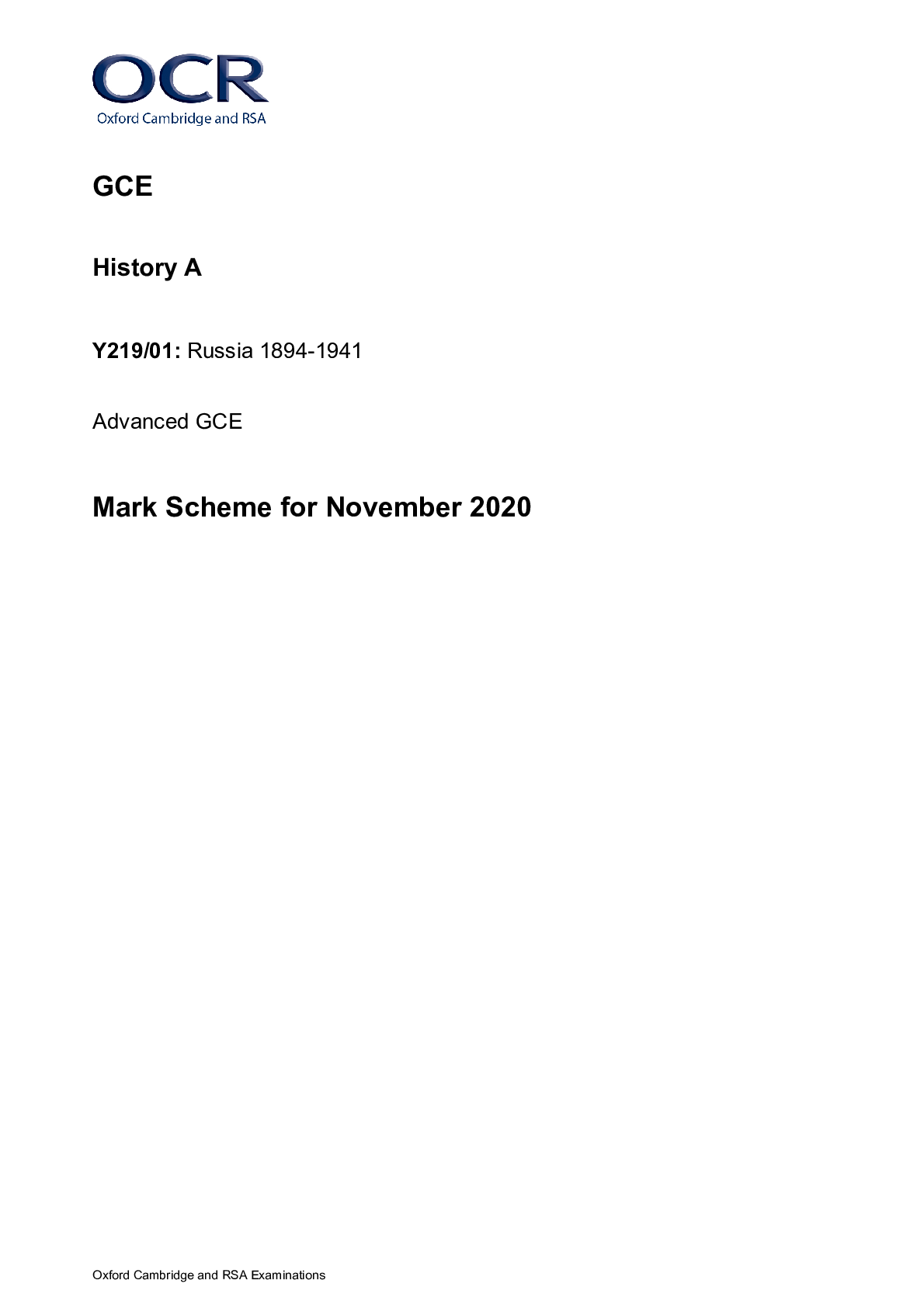
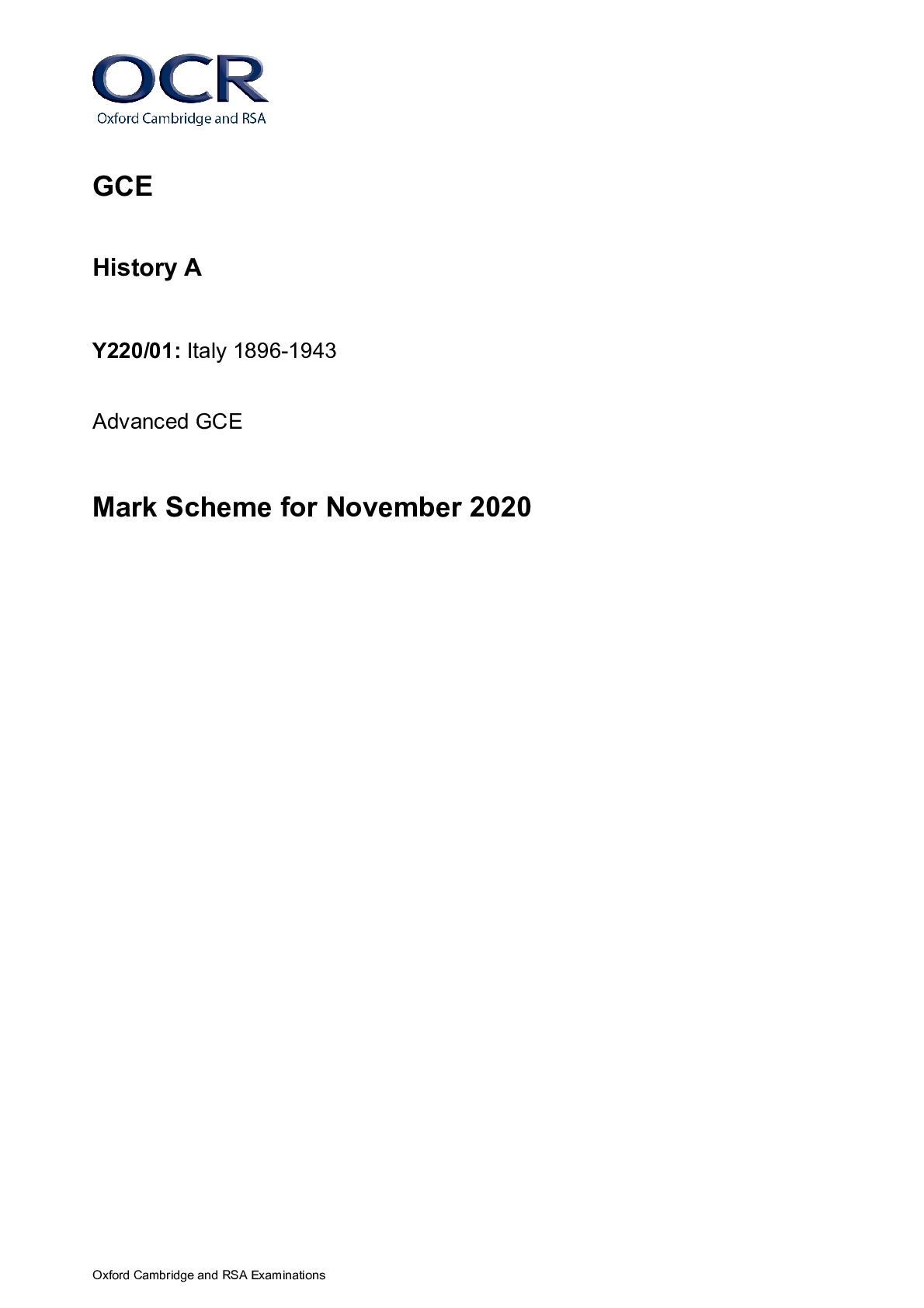

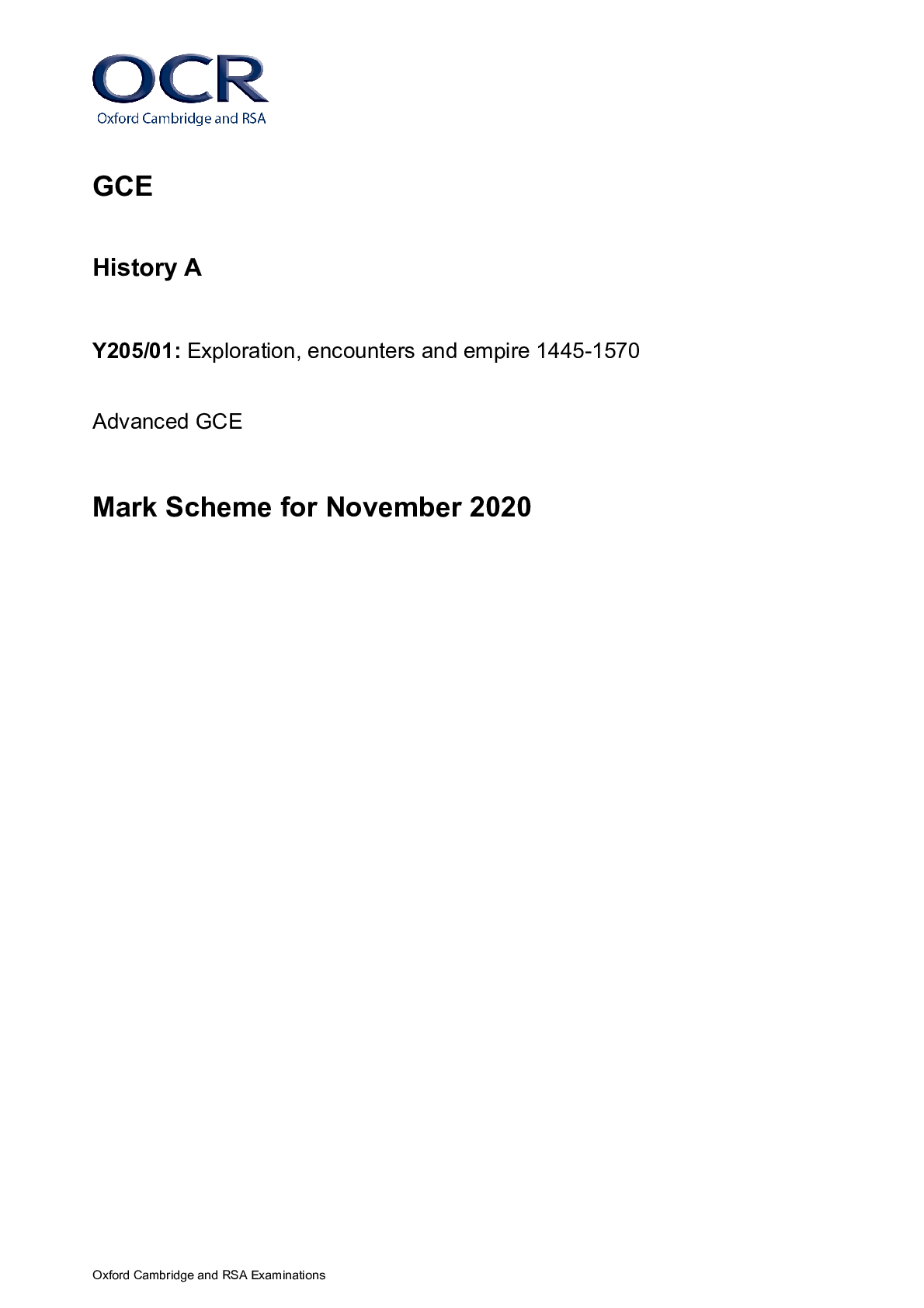
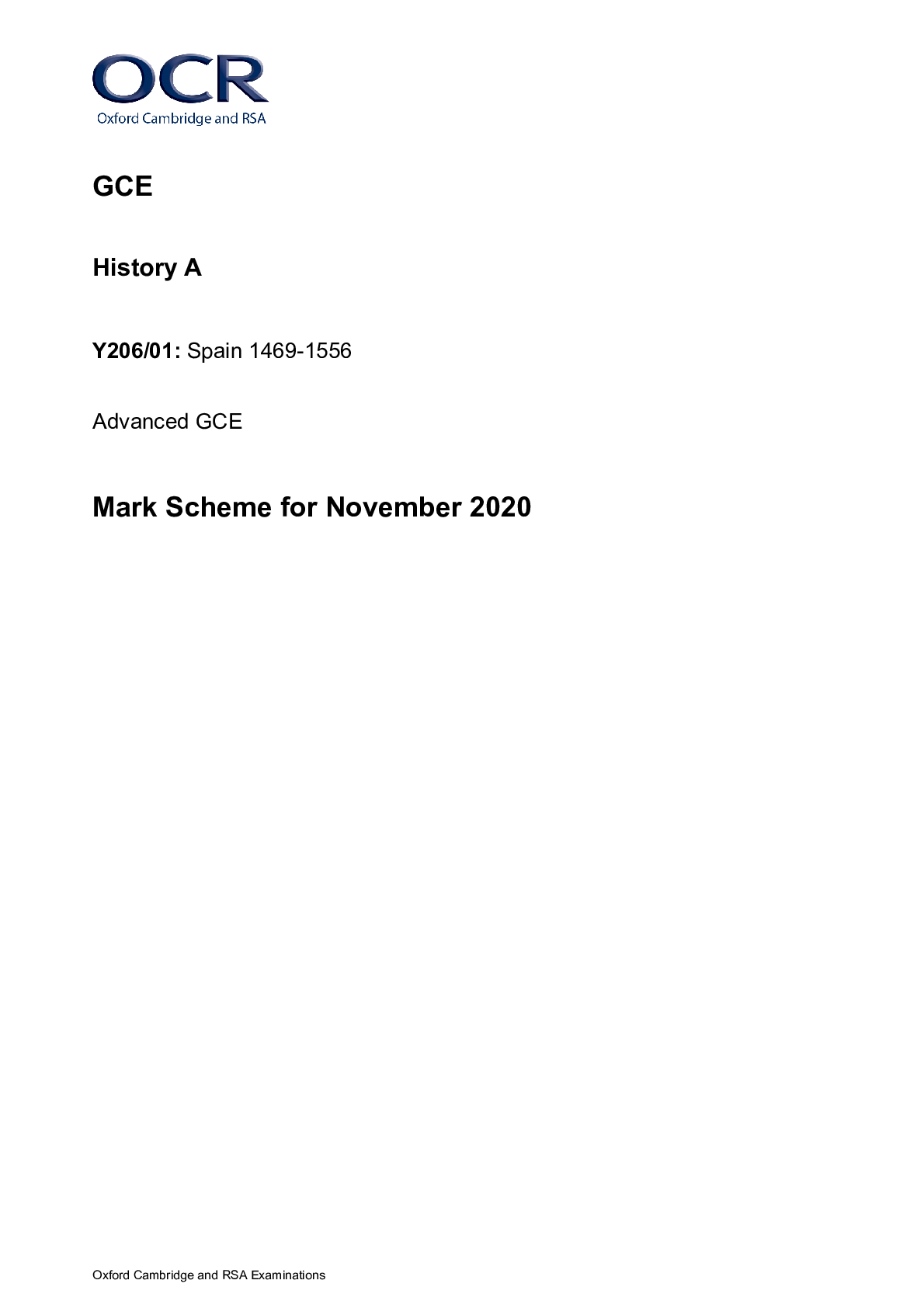
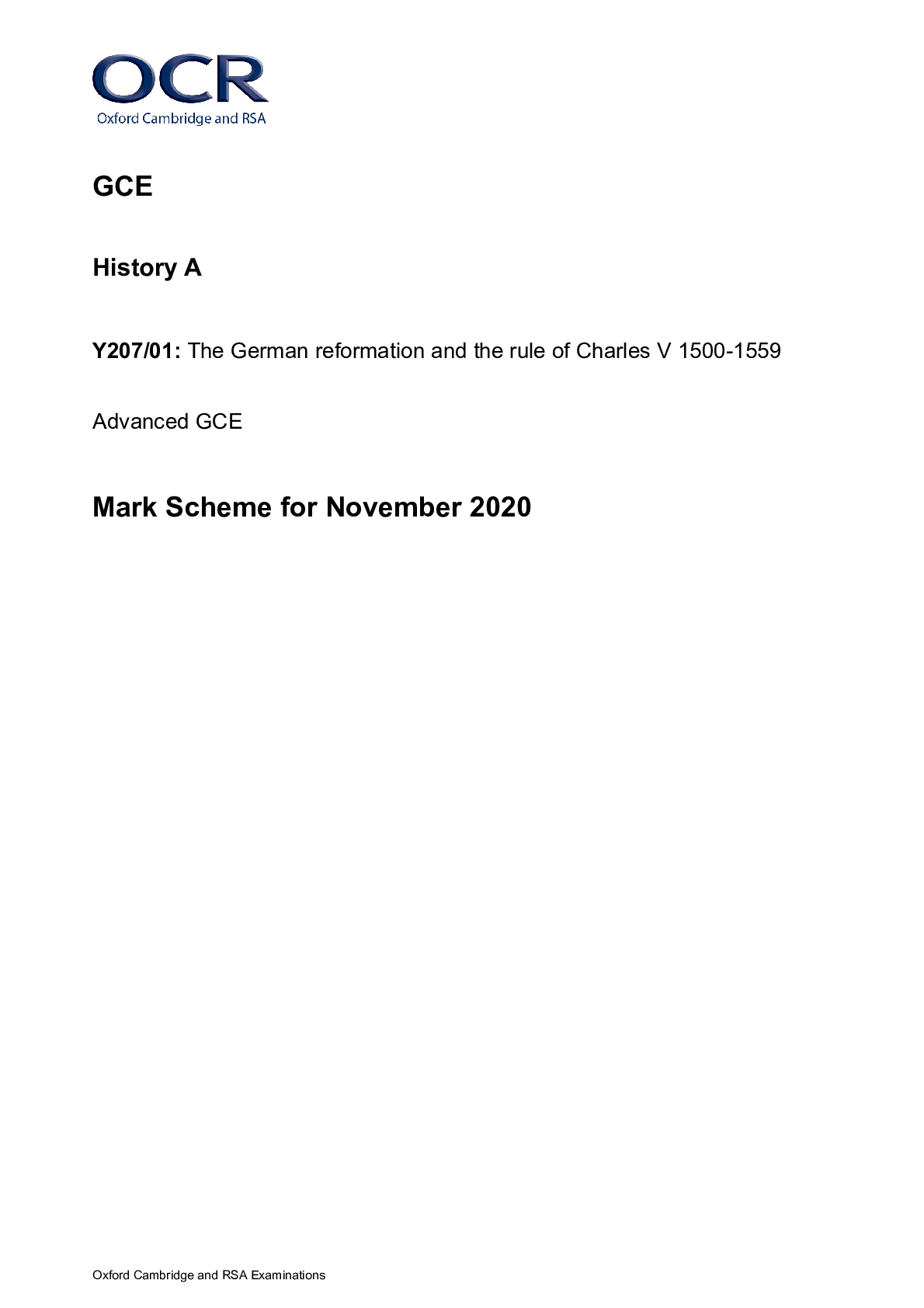
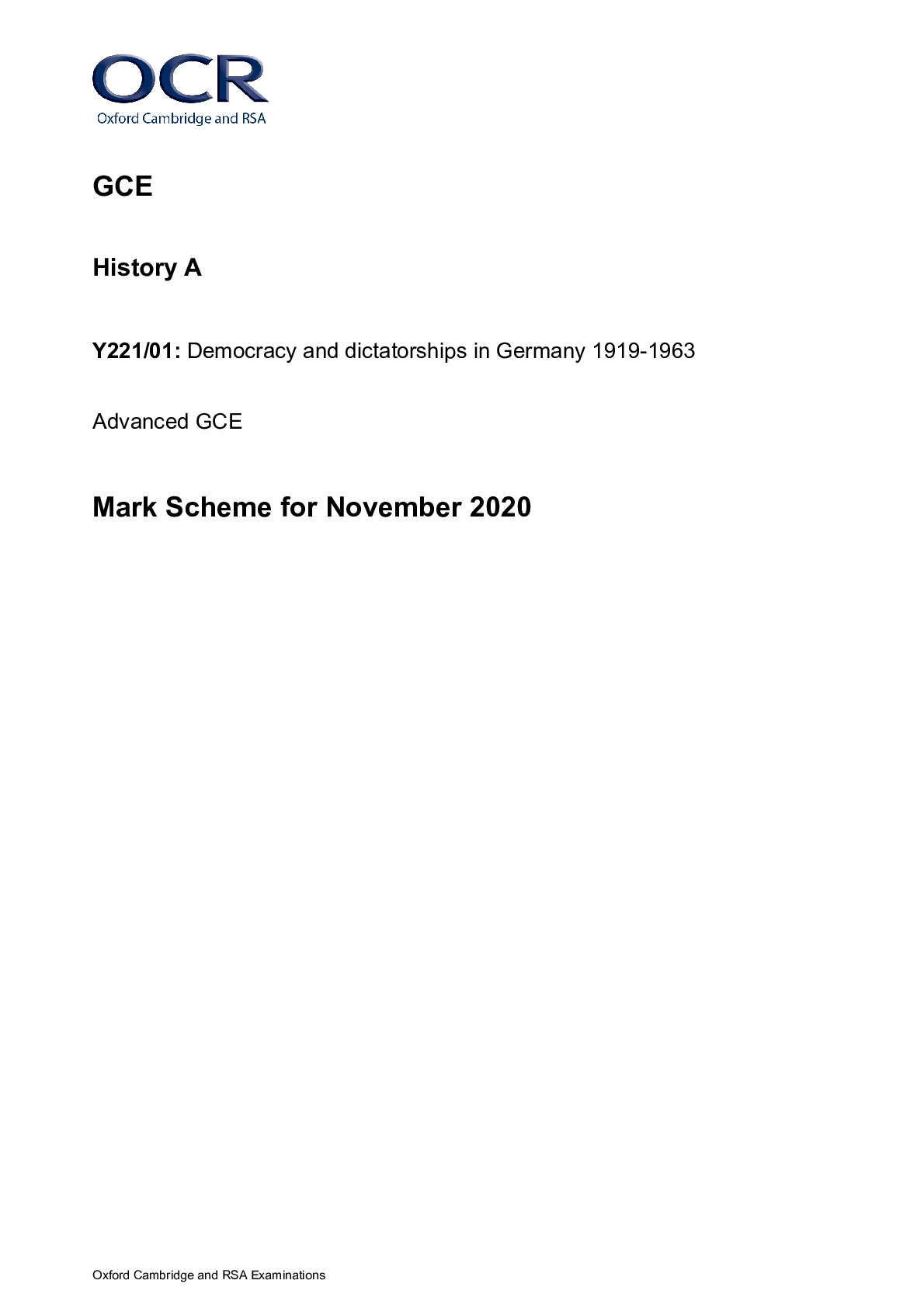

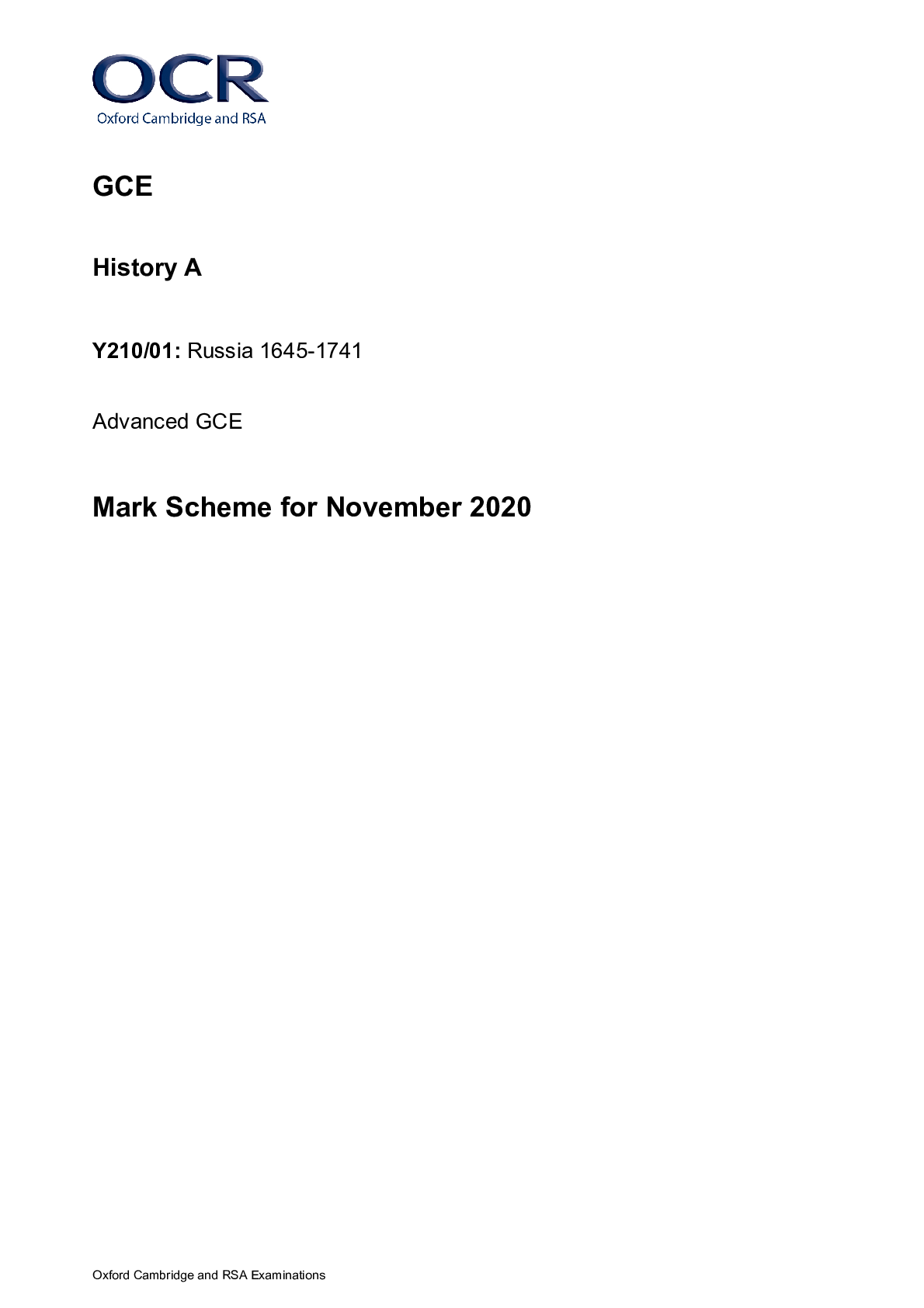


.png)






